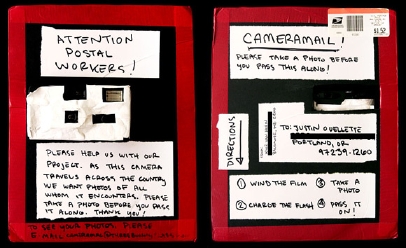Here are two activities I’ve come across focusing on visual storytelling:
- Photobooth Stories: This activity was an assignment for a class called
 Intermedia I in the Communication Studies Department at Concordia University. I’m guessing that the assignment was to tell a story using the 4 shots takes in a photo booth (as in the sample shown here). That’s one way to get story value from photobooth pix. I can imagine some expanded possibilities:
Intermedia I in the Communication Studies Department at Concordia University. I’m guessing that the assignment was to tell a story using the 4 shots takes in a photo booth (as in the sample shown here). That’s one way to get story value from photobooth pix. I can imagine some expanded possibilities:
- Tell a story of your own using photobooth pictures.
- Guess the artist’s intention in the deliberate photobooth stories of others, such as those on the class’s Web site.
- Make up a story about old sets of photobooth pix that were not necessarily intended to tell a story.
- Cameramail: Modeled a project undertaken between Daniel Farrell and Richard Kegler and described on the Web site P22, Cameramail involves gluing a one-use camera onto a postcard.Current project overseer, Kyle Van Horn suggests that in the past, the cameras were rewrapped, thus “creating a suspicious looking item” (you can see some of the re-wrapped specimens on Van Horn’s site.) Van Horn “cut a hole through the cardboard to allow the shooter to access the thumb-advance and use the viewfinder.” Trial and error apparently taught him that handwritten notes to postal workers are more effective than computer-printed, and red tape also is helpful. The idea behind the project becomes apparent when you read this note to postal workers: Photos should be taken of everyone the camera encounters. Postal workers are asked to take a photo before passing it along. (You can quite a few post-office photos in this iteration of the project results.) Van Horn says he “usually either take[s] a picture of the person at the desk, or have them take one of me as the first shot on the roll.” “Bryan” of the blog Infocult calls Cameramail a “new distributed storytelling technique.”

